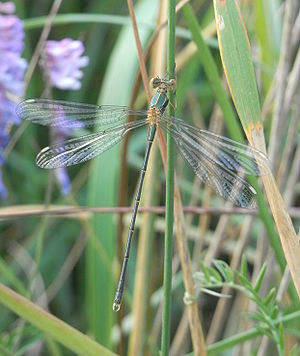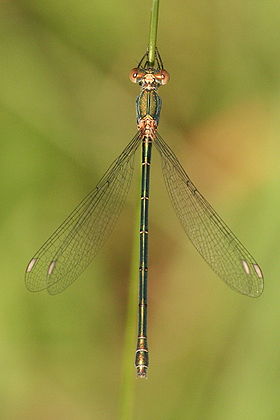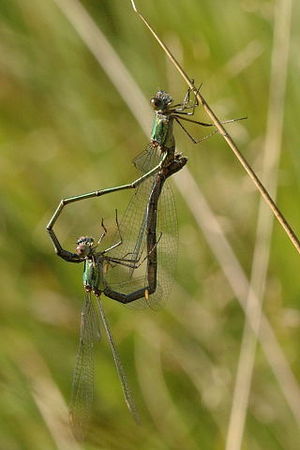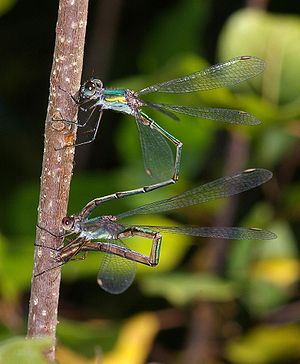
Lestes viridis
Encyclopedia
Chalcolestes viridis, formerly Lestes viridis, is a damselfly
of the family Lestidae
. It has a metallic green body and at rest it holds its wings away from its body. Its common name is the Willow Emerald Damselfly or the Western Willow Spreadwing.
is separated from Lestes
because of differences in their larvae.
A closely related species C. parvidens used to be considered a sub-species of C. viridis. C. parvidens occurs in Greece, Bulgaria, Croatia and in Italy; near Rome it flies with C. viridis in the same ponds. There are small morphological differences between the two species both as adults and larvae and analysis of proteins from the two species, by electrophoresis, also supports their separation into two species, but they are hard to tell apart in the field. C. parvidens flies earlier in the year than C. viridis.
with areas of overlap in Italy and the Balkans. C. viridis is found on many mediterranean islands including Corsica
, Sicily
, Mallorca
, Menorca and Ibiza
, in the Maghreb in North Africa, Turkey and the Middle East. However many of the old records for C. viridis in the east of its range could be for C. parvidens
. It occurs in still or slow flowing water in ditches, ponds, lakes and canals, with overhanging willows, alders or birches, which are used for breeding. Of all the European Lestes
it is the species, along with C. parvidens
, that will lay eggs in where there is running water. The adults are often found in the bushes which grow over or alongside water.
. Both species are mainly metallic green, like other Lestes
damselflies, but larger and darker but they do not have a powder blue pruinescence
which is common in other Lestes
. The pterostigma
is pale brown and outlined in black. The thorax
has thin yellow antehumerals and broader yellow stripe above a thin black line on each side; the upper edge of the stripe is irregular. Both C. viridis and C. parvidens
have a prominent spur-like marking on the side of the thorax.
Male - The abdomen
is very long. The lower anal appendages are less than half the length of the upper which are a distinctive pale yellow with black tips.
Female - The ovipositor is longer than in Lestes dryas
.
Mature males defend vertical territories in marginal shrubs and small trees where they find and mate with females in the normal damselfly manner forming the wheel position. Egg laying occurs with the pair in tandem, the eggs being laid into incisions in the bark of overhanging branches, not into submerged vegetation as is the case in many damselflies. Egg laying can result in distinct oval galls forming in the shrub's bark. The eggs develop rapidly for a few weeks and then enter a diapause state. In this state the eggs development is very slow and it is in this state that the eggs overwinter. The following spring the eggs hatch, the larvae drop into the water and start to develop. Growth is rapid and adults can emerge in a couple of months. After emerging the adults move away from water to mature. In this stage of their life-cycle the immature adults cannot breed. The adults need a period of time for their reproductice organs to develop and this non-breeding period also stops the adults breeding too early in the season. If the females lay eggs early in the year the eggs will develop when it is to warm to for them to enter diapause. They might hatch out before winter and the resultant larva will die when winter temperatures occur. When fully mature the adults return to water and start breeding.
Damselfly
Damselflies are insects in the order Odonata. Damselflies are similar to dragonflies, but the adults can be distinguished by the fact that the wings of most damselflies are held along, and parallel to, the body when at rest...
of the family Lestidae
Lestidae
Lestidae is a rather small family of cosmopolitan, large-sized, slender damselflies. They are of the order of the dragonflies and are commonly known as "Spreadwings." There are two subfamilies in Lestdae. The first subfamily is Lestinae. Damselflies in Lestinae rest with their wings partly open...
. It has a metallic green body and at rest it holds its wings away from its body. Its common name is the Willow Emerald Damselfly or the Western Willow Spreadwing.
Taxonomy
The genus ChalcolestesChalcolestes
Chalcolestes is a small genus of damselfly in family Lestidae. They are commonly known as Willow Spreadwings. They are similar to the Spreadwings of the genus Lestes....
is separated from Lestes
Lestes
Lestes is a genus of damselfly in family Lestidae. The family hold their wings at about 45 degrees to the body when resting. This distinguishes them from most other species of damselflies which hold the wings along, and parallel to, the body when at rest....
because of differences in their larvae.
A closely related species C. parvidens used to be considered a sub-species of C. viridis. C. parvidens occurs in Greece, Bulgaria, Croatia and in Italy; near Rome it flies with C. viridis in the same ponds. There are small morphological differences between the two species both as adults and larvae and analysis of proteins from the two species, by electrophoresis, also supports their separation into two species, but they are hard to tell apart in the field. C. parvidens flies earlier in the year than C. viridis.
Distribution and habitat
C. viridis is found across southern and central Europe. In the eastern mediterranean it is replaced by C. parvidensLestes parvidens
Chalcolestes parvidens, formerly Lestes parvidens, is a damselfly of the family Lestidae. It has a metallic green body and at rest it holds its wings away from its body. Its common name in English is the Eastern Willow Spreadwing.-Taxonomy:...
with areas of overlap in Italy and the Balkans. C. viridis is found on many mediterranean islands including Corsica
Corsica
Corsica is an island in the Mediterranean Sea. It is located west of Italy, southeast of the French mainland, and north of the island of Sardinia....
, Sicily
Sicily
Sicily is a region of Italy, and is the largest island in the Mediterranean Sea. Along with the surrounding minor islands, it constitutes an autonomous region of Italy, the Regione Autonoma Siciliana Sicily has a rich and unique culture, especially with regard to the arts, music, literature,...
, Mallorca
Mallorca
Majorca or Mallorca is an island located in the Mediterranean Sea, one of the Balearic Islands.The capital of the island, Palma, is also the capital of the autonomous community of the Balearic Islands. The Cabrera Archipelago is administratively grouped with Majorca...
, Menorca and Ibiza
Ibiza
Ibiza or Eivissa is a Spanish island in the Mediterranean Sea 79 km off the coast of the city of Valencia in Spain. It is the third largest of the Balearic Islands, an autonomous community of Spain. With Formentera, it is one of the two Pine Islands or Pityuses. Its largest cities are Ibiza...
, in the Maghreb in North Africa, Turkey and the Middle East. However many of the old records for C. viridis in the east of its range could be for C. parvidens
Lestes parvidens
Chalcolestes parvidens, formerly Lestes parvidens, is a damselfly of the family Lestidae. It has a metallic green body and at rest it holds its wings away from its body. Its common name in English is the Eastern Willow Spreadwing.-Taxonomy:...
. It occurs in still or slow flowing water in ditches, ponds, lakes and canals, with overhanging willows, alders or birches, which are used for breeding. Of all the European Lestes
Lestes
Lestes is a genus of damselfly in family Lestidae. The family hold their wings at about 45 degrees to the body when resting. This distinguishes them from most other species of damselflies which hold the wings along, and parallel to, the body when at rest....
it is the species, along with C. parvidens
Lestes parvidens
Chalcolestes parvidens, formerly Lestes parvidens, is a damselfly of the family Lestidae. It has a metallic green body and at rest it holds its wings away from its body. Its common name in English is the Eastern Willow Spreadwing.-Taxonomy:...
, that will lay eggs in where there is running water. The adults are often found in the bushes which grow over or alongside water.
Status in Britain
In Britain it was a rare vagrant and is now a new colonist. It is widespread on Jersey.Identification
In the field it is not possible to reliably distinguish C. viridis from C. parvidensLestes parvidens
Chalcolestes parvidens, formerly Lestes parvidens, is a damselfly of the family Lestidae. It has a metallic green body and at rest it holds its wings away from its body. Its common name in English is the Eastern Willow Spreadwing.-Taxonomy:...
. Both species are mainly metallic green, like other Lestes
Lestes
Lestes is a genus of damselfly in family Lestidae. The family hold their wings at about 45 degrees to the body when resting. This distinguishes them from most other species of damselflies which hold the wings along, and parallel to, the body when at rest....
damselflies, but larger and darker but they do not have a powder blue pruinescence
Pruinescence
Pruinescence, or pruinosity, is a "bloom" caused by pigment on top of an insect's cuticle that covers up the underlying coloration, giving a dusty or frosted appearance. The pruinescence is commonly white to pale blue in color, but can also be gray, pink, purple, or red; these colors may be...
which is common in other Lestes
Lestes
Lestes is a genus of damselfly in family Lestidae. The family hold their wings at about 45 degrees to the body when resting. This distinguishes them from most other species of damselflies which hold the wings along, and parallel to, the body when at rest....
. The pterostigma
Pterostigma
The pterostigma is a cell in the outer wing of insects which is often thickened or coloured and so stands out from other cells. It is particularly noticeable in dragonflies, but present also in other insect groups, such as snakeflies, hymenopterans and megalopterans.The purpose of the pterostigma,...
is pale brown and outlined in black. The thorax
Thorax (insect anatomy)
The thorax is the mid section of the insect body. It holds the head, legs, wings and abdomen. It is also called mesosoma in other arthropods....
has thin yellow antehumerals and broader yellow stripe above a thin black line on each side; the upper edge of the stripe is irregular. Both C. viridis and C. parvidens
Lestes parvidens
Chalcolestes parvidens, formerly Lestes parvidens, is a damselfly of the family Lestidae. It has a metallic green body and at rest it holds its wings away from its body. Its common name in English is the Eastern Willow Spreadwing.-Taxonomy:...
have a prominent spur-like marking on the side of the thorax.
Male - The abdomen
Abdomen
In vertebrates such as mammals the abdomen constitutes the part of the body between the thorax and pelvis. The region enclosed by the abdomen is termed the abdominal cavity...
is very long. The lower anal appendages are less than half the length of the upper which are a distinctive pale yellow with black tips.
Female - The ovipositor is longer than in Lestes dryas
Lestes dryas
Lestes dryas is a species of damselfly which is found across Europe, Asia and North America. In North America it is known as the Emerald Spreadwing and this name is becoming more widely used in Europe. In Britain, it is very rare so its common name is the Scarce Emerald Damselfly. An alternate name...
.
_5.jpg) |
 |
 |
Behaviour
Flight period is late from August to October although in the southernmost parts of its range it can occur as early as May and persist until November.Mature males defend vertical territories in marginal shrubs and small trees where they find and mate with females in the normal damselfly manner forming the wheel position. Egg laying occurs with the pair in tandem, the eggs being laid into incisions in the bark of overhanging branches, not into submerged vegetation as is the case in many damselflies. Egg laying can result in distinct oval galls forming in the shrub's bark. The eggs develop rapidly for a few weeks and then enter a diapause state. In this state the eggs development is very slow and it is in this state that the eggs overwinter. The following spring the eggs hatch, the larvae drop into the water and start to develop. Growth is rapid and adults can emerge in a couple of months. After emerging the adults move away from water to mature. In this stage of their life-cycle the immature adults cannot breed. The adults need a period of time for their reproductice organs to develop and this non-breeding period also stops the adults breeding too early in the season. If the females lay eggs early in the year the eggs will develop when it is to warm to for them to enter diapause. They might hatch out before winter and the resultant larva will die when winter temperatures occur. When fully mature the adults return to water and start breeding.
 |
 |

